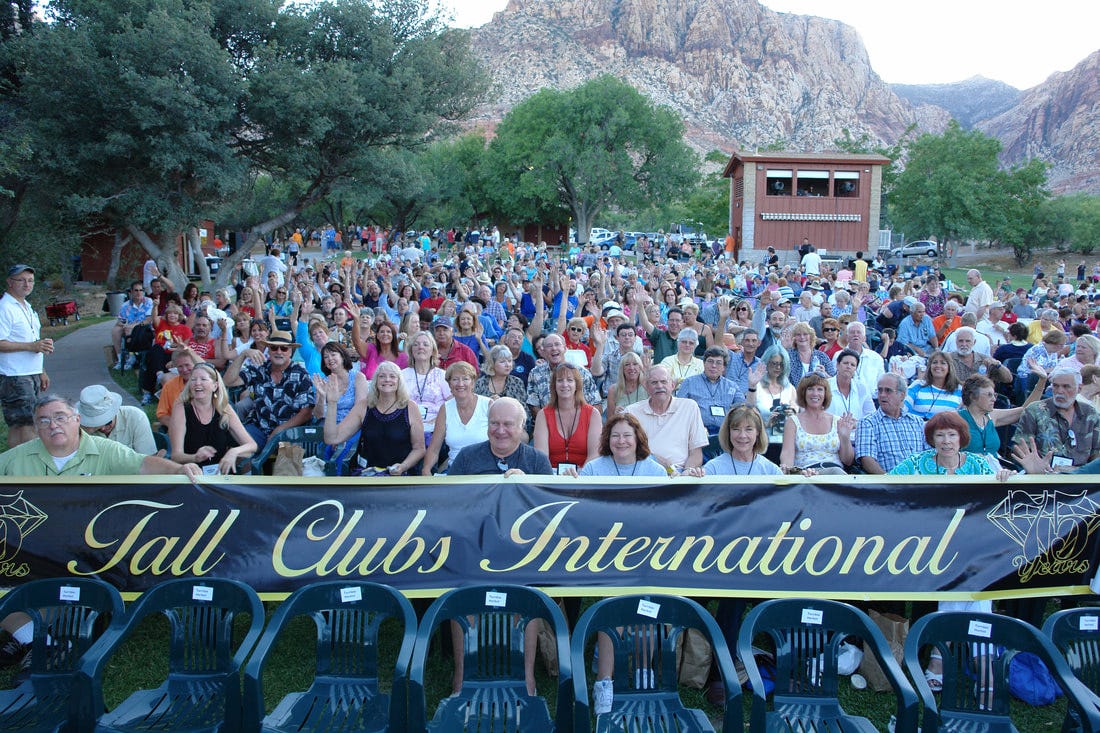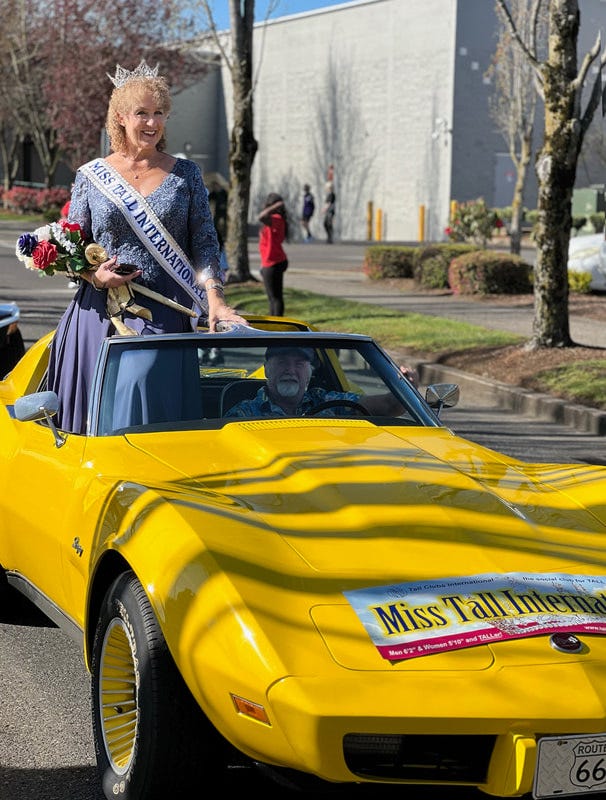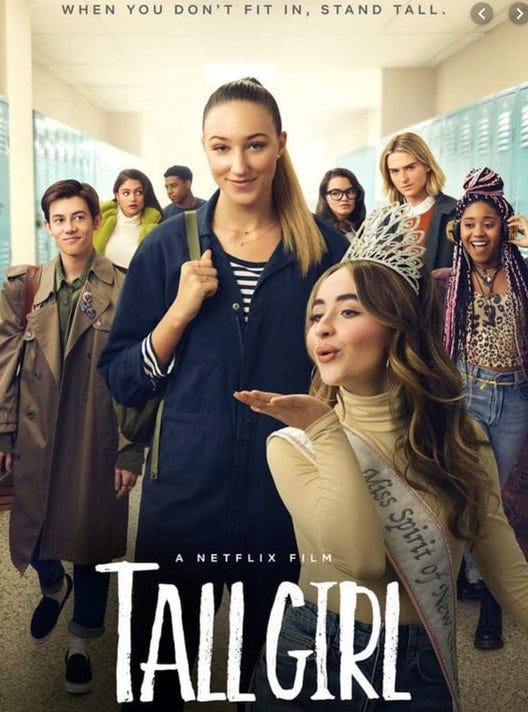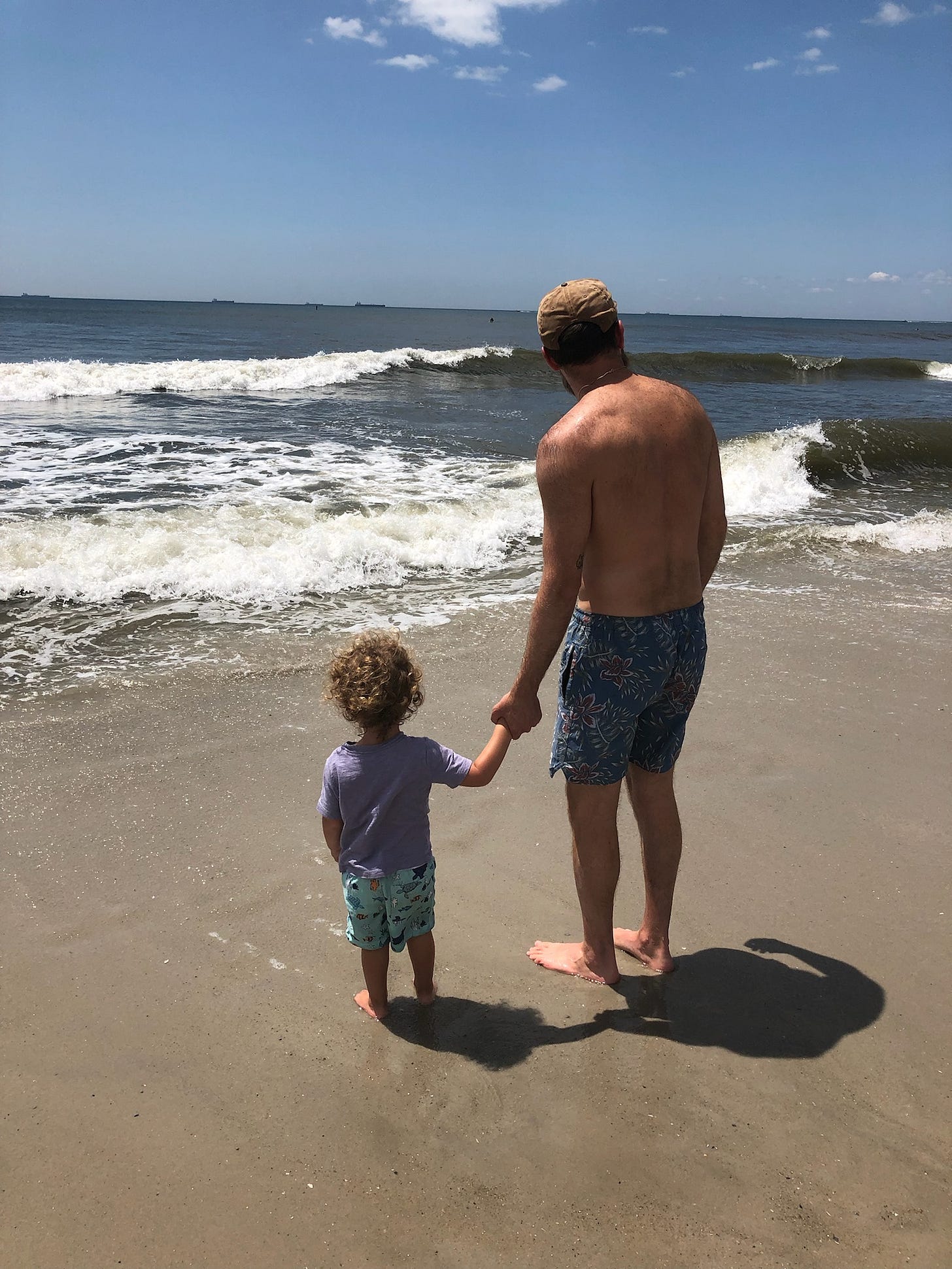The Fascinating Story of Tall Clubs International: A Global Community for Tall People
Plus 9 actionable lessons you can apply to your own community
👋 Hey community creators! Welcome to the 543 of you who joined this month.
Every Tuesday, I share a new post to help you become a smarter, more successful community creator.
If you’re not a subscriber, here’s what you missed this month:
Subscribe to get access to every post moving forward!
Once in a while, I discover a community and immediately want to learn everything I can about it.
That’s what happened when I stumbled onto Tall Clubs Intentional (TCI): a community of tall people that was started in 1938.
The requirements to join are very simple: women must be at least 5'10" and men at least 6'2" tall — barefoot. Don’t be trying to show up in heels. (The original requirements were 6’0” for women and 6’4” for men, but it was lowered to allow for more people to join)*.
Now most people would say that they’d like to be taller. You can see better at the theatre, reach the top of the cabinet, and become a powerful presence in any room. Heck, I wouldn’t mind a couple extra inches.
But being tall comes with its share of struggles. There’s the guilt that comes with blocking the view of people behind you. You stand out in a crowd, sometimes attracting gawks and stares. You have to duck under doorways and hit your knees on tables. And airplanes?!… more like torture chambers.
As hard as it might be to be tall today, it was much harder in 1938. Back then, most things weren’t built with tall people in mind. In fact, there were literally fewer tall people. Humans have been getting consistently taller since our overall nutrition started improving in the 1800s.
So if you were tall back in 1938, you were dealing with even lower doorframes, smaller tables, and more gawks. And it was near impossible to find clothes that fit.
Enter Kae Einfeldt: a 6’3” 22-year-old who was working for Disney as a cartoonist.
Kae first noticed that she was different when she was a kid, looked around, and none of the other girls could meet her eye level. “I felt so lonely up so high”, she recalled thinking.
Disney hired her specifically to work on a film called, I kid you not, "Snow White and the 7 Dwarfs". The irony wasn’t lost on Einfeldt, who said with a smirk, “I was soon known as the giant girl who painted dwarfs for Walt Disney.”
That was when she started thinking about organizing a tall club. “I painted dwarfs day after day, month after month, and I started thinking, we’re doing something nice for little people, but what about tall people?” After a lifetime of squeezing into bus seats and knocking her knees on the bottom of tables, she had had enough.
She decided to pitch the LA Times on an article about the struggles of the tall. She had a good reputation working at Disney which helped her get a “yes”, and they ran her piece titled, “Six-Foot-Three (What Will It Be?)?”.
At the end of the article, she invited anyone to reach out to her directly. Eight people did and North America's first club for tall people was born.
They called it the “Longfellows Club" (it would later become the “California Tip Toppers Club”). Their primary goal, at first, was “the development of tall furnishings”. Members wrote letters, made phone calls, and visited businesses to encourage them to lower the cost of custom-made items. They were able to convince at least one bedding company to create one of the first King size mattresses!
Over the next few years, the club grew, and soon a second tall club formed in Kansas City: The Greater Kansas City Skyliners. Things really took off when, on June 24, 1940, Life magazine published an article called “Life Goes to a Tip Toppers Party”. Soon tall clubs were springing up all over the country which, a few months later, led to Robert Ripley inviting Kae to appear on his show, “Believe It or Not” in New York. There were two full rows of Tip Toppers at the filming, showing just how far the community was spreading.
Eventually, in 1947, they decided they should bring all the clubs together for an annual convention. “Tall Clubs International” was born. The first convention was held in Hollywood, California with fifteen clubs in attendance (these names are incredible):
California Tip Toppers Club
Greater Kansas City Skyliners
Pittsburgh Tip Toppers
New York Stratoliners
Paramount Tall Club of Chicago
Tall Girl's Club of Chicago
Tower Club of Philadelphia
New Jersey Tip Topper Club
Texas Tip Toppers of Dallas
Golden Gate Tip Toppers
Skyscrapers Club of Cleveland
Vancouver Tip Toppers Club
St. Louis Tip Toppers
Houston Higher Ups
Seattle Timberliners
They’ve hosted the convention every year since. This year is on a cruise ship!
They also publish a regular newsletter called “Talking Tall”, and crown a “Miss Tall International” every year, who travels around as an ambassador, spreading awareness of tall issues.
On a local level, there continue to be dozens of member clubs and thousands of members around the world. Kae passed away in 1996, but her legacy has lived on.
It’s an incredible story, and there are a number of lessons we can take away from Kae and TCI about how to build communities:
1. Find the people who feel like they don’t matter
Kae recalled in an interview that, before starting a tall club, she, “didn’t know where all the tall people were. I guess they were hiding themselves away like I was.”
Tall people (ironically) felt unseen. The world was not designed for them. When you have a struggle that no one seems interested in fixing, you feel like you don’t matter.
Whenever you see a group who feels like they aren’t being seen by society, you have a golden opportunity to build community. You can make them feel like they matter.
2. Be strict on your requirements
Y’all know that I’m all about that empathetic exclusion. I talk about it often.
Another person who isn’t Kae might have said that the height requirements for TCI are just loose suggestions but everyone is welcome. They wouldn’t want to make short people feel excluded.
But that would have undermined the purpose of the community. Luckily Kae held strong. There aren’t many places that are designed for tall people in this world. This community was.
Communities are defined by who they exclude.
3. Grow your community by playing to your strengths
When tall clubs get together in public, people notice. They get curious. Kae recalls people coming up to them and asking them, “What show are you all in?”, assuming they were performers of some kind.
The upside is that their novelty made their community highly interesting from a media standpoint. They were story-worthy and were able to use it to their advantage.
This strategy is still serving them today! In the new Netflix film “Tall Girl”, the main character participates in a tall club, which has once again sent droves of new members to TCI.
4. Bring“good neighbor” energy
People would regularly talk about the massive positive impact Kae and TCI had on their lives.
When asked how she felt about that, Kae said, “I like to have everyone think I’m the girl next door, they can approach me any time with any tall problem at all and if I have an answer, I’d be happy to share it.”
This is the kind of energy community creators should always bring to their members.
Be that special neighbor whose door you can always knock on when you need someone to talk to, knowing that they’ll help you, hold space for you, and keep you safe.
5. Be funny
I love a community that knows how to have fun.
Right in their tagline, “Raising social standards since 1938”, TCI communicates the playful vibes of the community. Every club has a witty slogan like, “Life is too short not to be tall”. Even their names are witty: “The Skyscrapers Club of Cleveland”.
Humor is a powerful and underrated tool for connecting people. When we laugh, we let our guard down, we feel good, we enjoy each other.
Even communities about serious topics, like “The Dinner Party”, a community for people in their 20’s and 30’s who lost a loved one, can benefit from humor. After I made a joke I thought might have crossed a line, the founders told me not to worry, “we absolutely love dark humor here”.
6. Incentivize contributions with awards
TCI created a bunch of awards to incentivize clubs to stay active:
The Convention Travel Trophy: For the club that traveled the farthest
The Best Paper Award: I don’t know what this one is for, maybe a newsletter?
The Increased Membership Award: For the most membership growth
The Special Merit Award: for the most charitable contributions
The Publicity Award: for spreading awareness
The Attendance Award: the most members present at a convention
The “Man of the Year” and “Woman of the Year” for overall contributions to TCI
Identify the actions that you want members to take, and create awards for each one. I especially love things like the Convention Travel Trophy because it takes a barrier to participation (distance) and turns it into a challenge.
7. Design experiences that make members feel seen
Here’s some of the copy from this year’s TCI Convention at Sea:
“Welcome, Tall Clubs International members and guests, to the tallest ship on the Alaska cruise circuit! With ceiling heights of 9’6”+, Royal Caribbean’s Ovation of the Seas was made with TCI in mind.”
I mean come on… this is gold. They found the tallest ship for the tall convention?! Imagine the joy their members felt when they learned that for an entire convention, they will not have to duck.
It reminds me of how Naj Austin designed Ethel’s Club to make people of color feel seen. She filled all the bookcases with authors of color and put mirrors up everywhere so they would literally see themselves in the space.
It’s these little details that create what feels like community magic.
8. Distribute control with guide rails
The way communities scale is by setting guide rails around the aspects of the community they want to be consistent, and then giving community members creative freedom within those guide rails.
Looking at the list of groups who attended the first convention, you can see how something as simple as letting groups name themselves, “Tip Toppers”, “Stratoliners”, “Skyscrapers”, “Higher Ups”, can give them a distinct sense of humor and identity.
TCI set a “minimum height requirement”, but let local clubs decide what their specific requirements would be.
Local groups get to design their own experiences and culture while keeping to the values defined by the broader community.
This is the way.
9. Turn commonality into impact
Tall people didn’t feel like they had a voice but once they started gathering, they used their collective voice to raise awareness for tall issues. They worked to create change like getting King Size mattresses and better clothing options for tall people.
In 1992 they launched the Tall Clubs International Foundation, a separate nonprofit that offers scholarships to tall college-bound high school students.
I love it when a community activates for impact. Communities are all movements just waiting to happen.
—
I hope you enjoyed Tall Club International’s story as much as I did. They truly set a high bar for communities everywhere (sorry, I had to get one in).
Here’s a quick summary of the lessons we can take away from TCI:
Find the people who feel like they don’t matter
Be strict on your requirements
Grow your community by playing to your strengths
Bring “good neighbor” energy
Be funny
Incentivize contributions with awards
Design experiences that make members feel seen
Distribute control with guide rails
Turn commonality into impact
—
*Kae’s original chapter is the only one that still maintains the original height requirements of 6’0” for women and 6’4” for men. When asked why, Kae said, “…because our slogan is ‘The world’s highest society’.” Gotta respect the dedication to a good slogan.
This was my first “community breakdown” in this newsletter. Let me know what you think of this format and if you’d like to see more posts like this. And if you know of a community that would be interesting to break down, send it over!
🔥 Featured Community Jobs
Growth program Manager, Community Engagement, Journey Clinical (Remote)
Developer Relations and Community Manager, Visier (Remote)
Community Coordinator, BrainStation (NYC)
👉 View more community jobs here
Another company just successfully hired someone from my collective last week. Post your job on my talent collective and you’ll be featured in my newsletter + get access to 238 curated candidates!
🍭 Brain Candy
🤖 I’ve been thinking a lot about “artificial intimacy”. I think AI is going to make us lonely. But it turns out AI is already comforting millions of lonely people in China. The average interaction length between users and a bot called XiaoIce is 23 exchanges. “That is longer than the average interaction between humans."
🔬 What is the anatomy of a successful community post? (from April MacLean)
💃 Oy, so much facilitation! Can we just keep our communities casual? (From Sarah Greisdorf)
👩⚕️ Doctors help with physical health. Therapists help with mental health. Who will help us with social health?
🛞 The SoulCycle founders have a new project called PeopleHood, which is “like a workout for your relationships.” Fascinating. Would you go to one of these ”gathers”?
That’s all for this week!
I had a wonderful Father’s Day with my family down in Long Beach. Lucca was loving the waves.
Hope all you Fathers out there had a wonderful day too. Being a dad is the best, it’s truly the thing I’m most grateful for in life.
Lots more goodness in the newsletter next week!
Until then…
Thanks for building community.
-David “no dada I want mama” Spinks










My dad was tall, and I'm pretty tall (not tall enough to be in the club, though- flat 6 feet). There are certainly disadvantages that most regular sized folks just don't understand, but shortened lifespan is one thing everyone gets right away.
Absolutely love the Community Breakdown format!
It's easy to start thinking inside the proverbial box of your niche/industry when building communities. Lessons from such curious cases let you see why people come together in an entirely new light.
Looking forward to the next edition 🙌